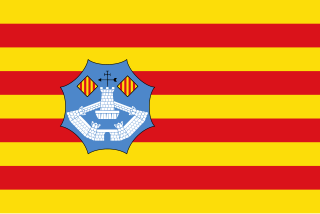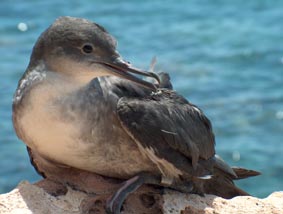
Mallorca, or Majorca, is the largest island of the Balearic Islands, which are part of Spain, and the seventh largest island in the Mediterranean Sea.

Menorca or Minorca is one of the Balearic Islands located in the Mediterranean Sea belonging to Spain. Its name derives from its size, contrasting it with nearby Mallorca. Its capital is Mahón, situated on the island's eastern end, although Menorca is not a province and forms a political union with the other islands in the archipelago. Ciutadella and Mahón are the main ports and largest towns. The port of Mahón is the second biggest natural port in the world.

Shearwaters are medium-sized long-winged seabirds in the petrel family Procellariidae. They have a global marine distribution, but are most common in temperate and cold waters, and are pelagic outside the breeding season.

The Balearic shearwater is a medium-sized shearwater in the seabird family Procellariidae. Puffinus is a Neo-Latin loanword based on the English "puffin" and its variants, that referred to the cured carcass of the fat nestling of the Manx shearwater, a former delicacy. The specific mauretanicus refers to Mauretania, an old name for an area of North Africa roughly corresponding to Morocco and Algeria. The Balearic Shearwater is listed critically endangered by the IUCN and is one of Europe’s most endangered seabirds.

Cory's shearwater is a large shearwater in the seabird family Procellariidae. It breeds colonially of rocky islands in the eastern Atlantic. Outside the breeding season it ranges widely in the Atlantic. It was formerly considered to be conspecific with Scopoli's shearwater.

The little shearwater is a small shearwater in the petrel family Procellariidae. Despite the generic name, it is unrelated to the puffins, which are auks, the only similarity being that they are both burrow-nesting seabirds.

The yelkouan shearwater, Levantine shearwater or Mediterranean shearwater is a medium-sized shearwater in the seabird family Procellariidae. It was formerly treated as a subspecies of the Manx shearwater.

Calonectris is a genus of seabirds. The genus name comes from Ancient Greek kalos, "good" and nectris, "swimmer".

Sobrassada in Catalan or Sobrasada in Spanish, is a raw, cured sausage from the Balearic Islands (Spain) made with ground pork, paprika, salt and other spices. Sobrassada, along with botifarró, are traditional Balearic meat products prepared in the laborious but festive rites that still mark the autumn and winter pig slaughter known as a matança in Minorca, Majorca and Ibiza. The chemical principle that makes sobrassada is the dehydration of meat under certain weather conditions which are typical of the late Balearic autumn.
Mediterranean shearwaterPuffinus mauretanicussensu lato was the name used during the 1990s for what was then regarded as a polytypic species of Puffinus shearwater, but which is now regarded as two separate monotypic species:

The Balearic Sea also known as Iberian Sea, is a body of water in the Mediterranean Sea between the Balearic Islands and mainland Spain. The Ebro River flows into this small sea.

Balearic cuisine is a Mediterranean cuisine as cooked in the Balearic Islands, Spain. It can be regarded as part of a wider Catalan cuisine, since it shares many dishes and ingredients with Catalonia and the Valencian Community. Others view it as part of a more global Spanish cuisine. Traditional Balearic cuisine is rich in vegetables, cereal and legumes as well as being low in fats. A succinct selection of the primary dishes would be ensaimades, seafood and vegetable stews, sobrassada, coques, tombet, Maó cheese and wine.
Balearic trance, also known as Ibiza trance is a trance music subgenre which evolved from Balearic beat. The earliest known Balearic trance compositions date back to a few years after the emergence of Balearic beat in the 1990s.

The Balearic Islands are an archipelago in the western Mediterranean Sea, near the eastern coast of the Iberian Peninsula. The archipelago conforms a province and autonomous community of Spain, with Palma de Mallorca being its capital and largest city.
Pterodromoides is an extinct genus of fulmarine petrel dating from the Late Miocene. It contains a single species, P. minoricensis. Its fossil remains were first discovered at the Punta Nati palaeontological site on the island of Menorca in the Balearic archipelago of the western Mediterranean. An additional specimen from North Carolina, USA has also been referred to this species, suggesting it lived across the North Atlantic. It was described in 2001, with the authors justifying the creation of a new genus by the large orbitonasal opening and characters of the postcranial skeleton, despite the similarity of the cranial osteology to that of Pagodroma.

Scopoli's shearwater is a seabird in the petrel family Procellariidae. It breeds on rocky islands and on steep coasts in the Mediterranean but outside the breeding season it forages in the Atlantic. It is brownish grey above with darker wings and mostly white below. The bill is pale yellow with a dark patch near the tip. The sexes are alike. It was formerly considered to be conspecific with Cory's shearwater.

La Mola is a peninsula that forms the eastern end of the island of Formentera, in the Balearic Islands of Spain, in the western Mediterranean Sea. It contains the highest part of the island, with an elevation of about 200 m, as well as the village of El Pilar de la Mola, and is surrounded by high coastal cliffs. The natural vegetation of the peninsula includes native coniferous woodland as well as garrigue and maquis shrubland. The main human uses of the peninsula include hunting and arable agriculture.

Cape Barbaria, or Cap de Barbaria, is a cape that marks the south-western end of the island of Formentera in the Balearic Islands of Spain in the western Mediterranean Sea. The natural vegetation of the cape includes shrubland and small patches of Pinus halepensis and Juniperus phoenicea forest. Human uses of the cape include hunting and agriculture.














